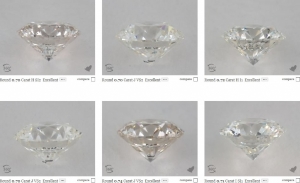With all the talk of colour I've seen popping up lately, it got me a little curious. I'm new to the forum, and green in terms of diamond exposure. The mathematical aspects I've got no issues working with. So in saying that, I hope I'm not breaking any forum rules with this thread.
Attached photos are courtesy of James Allen, taken through a screen shot. All diamonds have their description below. Prices removed as not required. All are GIA graded, with exception to the top right H which is has an IGI cert. These diamonds weren't selected to make a case. I simply chose 3 colours with ideal/ex cut properties and allowed them to sort by default.
As you can see, there is considerable colour variation between the images, and across the colour sprectrum. The top H appears similar to the lower J. The J's and I's almost appear imo to be the clearest/carry less colour than the rest in this sample, which leads into the next part.
My limited exposure has proven diamonds very difficult to capture in photos, colour even more so. Are the variances seen here more to do with the actual photographs, or the diamonds themselves, or does the particular grader play a bigger role than a lot of people give credit for?

Personally, I think the photographs may be the difference and would trust the graders call over the picture.. simply due to the AGS0 stone I recently purchased. It was on the less clear side of the scale when viewed online. It was an I which appeared closer to J, but in person even when set and viewed from the side it appears colourless to my naked eye. Its also set in yellow gold which likely enhances the diamond in comparison to if it were in white.
Attached photos are courtesy of James Allen, taken through a screen shot. All diamonds have their description below. Prices removed as not required. All are GIA graded, with exception to the top right H which is has an IGI cert. These diamonds weren't selected to make a case. I simply chose 3 colours with ideal/ex cut properties and allowed them to sort by default.
As you can see, there is considerable colour variation between the images, and across the colour sprectrum. The top H appears similar to the lower J. The J's and I's almost appear imo to be the clearest/carry less colour than the rest in this sample, which leads into the next part.
My limited exposure has proven diamonds very difficult to capture in photos, colour even more so. Are the variances seen here more to do with the actual photographs, or the diamonds themselves, or does the particular grader play a bigger role than a lot of people give credit for?

Personally, I think the photographs may be the difference and would trust the graders call over the picture.. simply due to the AGS0 stone I recently purchased. It was on the less clear side of the scale when viewed online. It was an I which appeared closer to J, but in person even when set and viewed from the side it appears colourless to my naked eye. Its also set in yellow gold which likely enhances the diamond in comparison to if it were in white.







300x240.png)